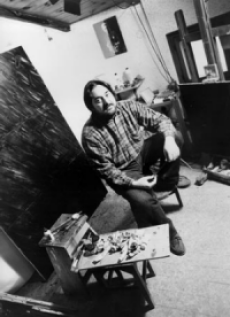  |
Born in Feltre in 1949, the artist works in Venice and Milan, where he teaches Painting at the Brera Academy of Fine Arts. He has a background of classical studies and a degree in Italian Literature from Padua University. He is the co-founder and editor of several art reviews: "Informazione Arti Visive" in Venice, "Creativa" in Genoa, "Artivisive" in Rome, and "Qnst", also in Venice. In the early 70s he used the media offered by the conceptual explosion of those years (visual writing, photography, video, live performances) winning wide international acclaim for his personal lyrical narrative interpretation. But, in the mid-70s, he turned his attention back to painting. |
but he began exploring the further possibilities of a mode that he himself had defined as early as 1976, long before anyone else, as New Romanticism. Viola's paintings represent a subjectivity, an inner probing into his own deep lyrical nature, that earlier conceptual research had partly put aside.
The culmination of these experiences is to be seen in Maree (Tides) (1983-1986), considered
by numerous art critics such as E. Crispolti, M. Vescovo, and G. Mazzariol,
as one of the highest achievements of his works.
In Maree, the tides depict the landscapes of the soul in which the memory of man and nature,
the Chaos of traces evolve into a new orderly Cosmos of natural and chemical waste,
a novel composite with a posthumous character.
This in turn was the catalyst for the idea behind Paesaggi d'esilio (Landscapes from exile), (1987-1993), new interior landscapes that even more successfully and more radically represent
the sentiment of Nature as an ambiguous content, forever swaying between irreparable loss
and tormented yearnings for rebirth.
Opere dell'esilio (Works from exile) also comprise Viola's latest production, Aree di natura protetta (Protected wild life areas) and Morte nature (Still lives).
If these later works seem to deny the positive side, the warmth of the exquisitely pictorial act,
while actually stressing its positive meaning, they do nonetheless freely re-articulate
the cold images from the desert of technological communication (xerox copies, photos, etc.)
in the space all around the painting, coupling them with other un-natural artifacts
(fiberglass, carbon fibers, kevrak, textiles, meals, etc).
This juxtaposition gives rise to a sort of conceptual Super realism that forcefully tackles
the theme of humanization as, in its insignificance, it represents
the most true and recognizable nature of contemporary mankind.

For more information please

Luigi Viola
© Copyright All Rights Reserved : Luigi Viola 1997
